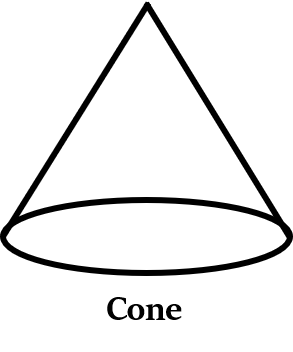Mensuration - Cone
What is a Cone?
A cone is a three dimensional solid structure, whose base is a circle and it has a vertex.
The most famous type of cone is Right Circular Cone. It is a cone whose vertex is directly over the center of its base circle. When we just mention ‘Cone’, we generally mean a ‘Right Circular Cone’.
When we just mention ‘Cone’, we generally mean a ‘Right Circular Cone’.
Formulae related to Cone
If ‘r’ is the radius of its base, ‘h’ is its height, and ‘l’ is its slant height, then:

Formula 1: Volume
Volume of cone = $\frac{1}{3}$ x Area of the base x Height = $\frac{1}{3} πr^2 h$
Formula 2: Surface Area
Lateral/Curved Surface area of cone = $\frac{1}{2}$ x Perimeter of the base x slant height = πrl
Total Surface area of cone = Lateral surface area + Area of the base = π rl + π$r^2$ = π r(l + r)
Formula 3: Frustum of a Cone
A frustum is the portion of a 3-D solid figure that lies between one or two parallel planes cutting it.
For example, frustum of a cone, frustum of a pyramid, etc.
To get frustum of a cone, we cut it by a plane parallel to its base. The portion of solid between this plane and the base of the original cone is known as the frustum of cone.
Volume of the frustum of the cone = $\frac{1}{3} πh (r_1^2 + r_2^2 + r_1r_2)$
Curved surface area of frustum of cone = $π(r_1 + r_2)s$, where s = $\sqrt{h^2 + (r_1 - r_2)^2}$
Total surface area of frustum of cone = $πs (r_1 + r_2)+ πr_1^2 + πr_2^2$, where s = $\sqrt{h^2 + (r_1 - r_2)^2}$
